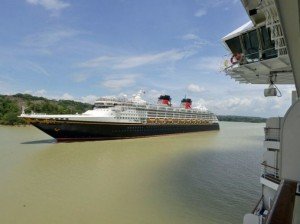
(Cntraveler) Did you know that they’re building new locks at the Panama Canal that should double the number of ships that can transit by next year? Did you know that each transit uses 52 million gallons of fresh water? Did you know that crossing the Canal from the Pacific Ocean to the Atlantic is actually a journey from east to west (as the Canal follows the shape of the Isthmus of Panama)?
I learned all this yesterday on board Oceania Cruises’ Marina as we journeyed through the Canal en route from Ecuador to Colombia. I already knew that the Canal is 50 miles long and takes ten hours to transit, and that, for ships headed from one coast of the United States to the other, it eliminates a 9,000-mile sea voyage around South America. But I was surprised to see that, at nearly 100 years old, the Canal still uses the same technology it used in 1914. And I was astonished to learn how high the tolls are that ships must pay to pass through. The cost depends on a variety of factors including a ship’s tonnage and number of passengers. Marina, which weighs 66,000 tons and has 1,258 passengers, paid $265,000 for our transit. Apparently the most expensive transit ever was the Norwegian Pearl’s; it cost Norwegian Cruise Line $483,000.
The new locks under construction will be much larger than the ones we went through yesterday. We had only two feet of clearance on either side of our ship! The new locks will be 70 feet wider and 400 feet longer, and there will be a couple of mechanical differences too: The gates will be sliding rather than hinged, and most of the fresh water will be recycled. The revenue earned from tolls is expected to increase from $1.5 billion to $5 billion per year.
Come with us on our journey through the Canal via this slide show of photos that my husband and I shot from various perches on board Marina.
